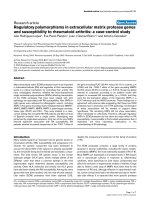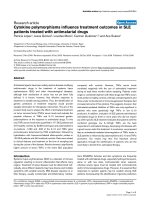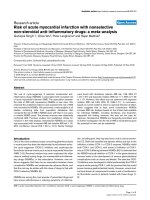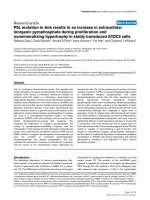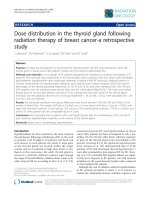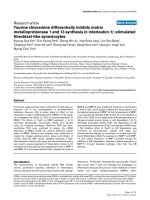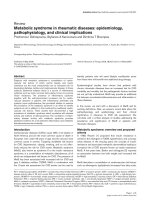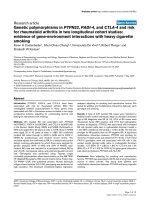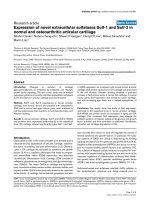Báo cáo y học: "Regulatory polymorphisms in extracellular matrix protease genes and susceptibility to rheumatoid arthritis: a case-control study" ppsx
Bạn đang xem bản rút gọn của tài liệu. Xem và tải ngay bản đầy đủ của tài liệu tại đây (182.83 KB, 7 trang )
Open Access
Available online />Page 1 of 7
(page number not for citation purposes)
Vol 8 No 1
Research article
Regulatory polymorphisms in extracellular matrix protease genes
and susceptibility to rheumatoid arthritis: a case-control study
Julio Rodriguez-Lopez
1
, Eva Perez-Pampin
1
, Juan J Gomez-Reino
1,2
and Antonio Gonzalez
1
1
Research Laboratory 2 and Rheumatology Unit, Hospital Clinico Universitario de Santiago, Santiago de Compostela, Spain
2
Department of Medicine, University of Santiago de Compostela, Santiago de Compostela, Spain
Corresponding author: Antonio Gonzalez,
Received: 16 Aug 2005 Revisions requested: 26 Sep 2005 Revisions received: 3 Oct 2005 Accepted: 10 Oct 2005 Published: 1 Nov 2005
Arthritis Research & Therapy 2006, 8:R1 (doi:10.1186/ar1849)
This article is online at: />© 2005 Rodriguez-Lopez et al.; licensee BioMed Central Ltd.
This is an Open Access article distributed under the terms of the Creative Commons Attribution License ( />2.0), which permits unrestricted use, distribution, and reproduction in any medium, provided the original work is properly cited.
Abstract
Many extracellular matrix (ECM) proteases seem to be important
in rheumatoid arthritis (RA) and regulation of their transcription
levels is a critical mechanism for controlling their activity. We
have investigated, therefore, whether the best-characterized
single nucleotide polymorphisms (SNPs) affecting transcription
of the ECM proteases that have been related with joint
pathology are associated with RA susceptibility. Nine SNPs in
eight genes were selected by bibliographic search, including
SNPs in the genes encoding matrix metalloproteinase (MMP)1,
MMP2, MMP3, MMP7, MMP9, MMP13, plasminogen activator,
tissue type (PLAT) and PAI-1. They were studied in a case-
control setting that included 550 RA patients and 652 controls
of Spanish ancestry from a single center. Genotyping was
performed by single-base extension. Only two of the nine SNPs
showed significant association with RA susceptibility. RA
patients showed increased frequencies of the -7351 T allele of
the gene encoding PLAT (36.4% versus 32.1% in controls, p =
0.026) and the -1306 T allele of the gene encoding MMP2
(24.5% versus 20.3% in controls, p = 0.013). These two alleles
seemed to cooperate according to an additive model with
respect to increased RA susceptibility (p = 0.004), and they
were the low-expression alleles of the respective SNPs in a
PLAT enhancer and the MMP2 promoter. These findings are in
agreement with previous data suggesting that these two ECM
proteases have a protective role in RA pathology. Confirmation
of these associations will be needed to support these
hypotheses. The remaining SNPs did not show association,
either individually or collectively. Therefore, although regulatory
SNPs in ECM proteases did not show any major effect on RA
susceptibility, it was possible to find modest associations that, if
replicated, will have interesting implications in the
understanding of RA pathology.
Introduction
Many studies support an important role for genetic factors in
rheumatoid arthritis (RA) susceptibility and progression [1].
Overall, the genetic component has been estimated to
account for about 50% of the variance in disease susceptibil-
ity, the remainder being environmental and stochastic compo-
nents. The best known RA genetic factor is the human
leukocyte antigen (HLA) gene, where multiple alleles of the
DRbeta1 chain that share a common epitope in the third
hypervariable region determine disease susceptibility and
severity. Other HLA molecules and several non-HLA genes
have also been related with RA susceptibility. Among the many
genes that have been studied, only two that encode extracel-
lular matrix (ECM) proteases have been explored [2-6],
despite the unequivocal involvement of this family of proteins
in RA.
The ECM proteases comprise a large family of proteins
grouped in several subfamilies, including the matrix metallo-
proteinases (MMPs), the most extensively studied in RA [7-9].
Many MMPs are expressed at increased levels in RA tissues
and in synoviocyte cultures in response to inflammatory
cytokines, show specificity for joint tissue components and
affect the evolution of experimental models of arthritis. Drugs
able to inhibit a wide array of MMPs have been tried for the
treatment of RA and, although effective in experimental mod-
els, human clinical trials had to be discontinued due to intoler-
able side effects. It is expected that more specific protease
CI = confidence interval; ECM = extracellular matrix; IQR = interquartile range; LD = linkage disequilibrium; MMP = matrix metalloproteinase; OR =
odds ratio; PAI = plasminogen activator inhibitor; PCR = polymerase chain reaction; PLAT = plasminogen activator, PLAU: plasminogen activator,
urokinase tissue type; RA = rheumatoid arthritis; SAP = shrimp alkaline phosphatase; SNP = single nucleotide polymorphism.
Arthritis Research & Therapy Vol 8 No 1 Rodriguez-Lopez et al.
Page 2 of 7
(page number not for citation purposes)
inhibitors will retain therapeutic potential without the associ-
ated side effects. It is unclear what ECM proteases to target
with these drugs, however, because it has been difficult to
ascertain the specific participation of each of them in RA. As a
group, they are the major actors in the degradation of ECM in
RA cartilage and bone. In addition, they increase and perpetu-
ate joint inflammation through the activation of cytokines,
chemokines and other proteases by cleavage of their precur-
sors at specific sites [7-10]. They can also contribute to inflam-
mation by exposing cryptic epitopes in ECM components that
have biological actions in angiogenesis, cell migration and pro-
liferation [10]. The difficulty in discerning the specific role of
each of the ECM proteases found in the joints stems from the
apparent redundancy of their effects and the wide variety of
targets that each could degrade. We expect that genetic stud-
ies will provide clues to the identities of proteases that are crit-
ical for the RA process.
We have searched bibliographic databases for ECM pro-
teases and their specific inhibitor proteins that have been
described as involved in cartilage homeostasis and joint
pathology. About 35 were identified with very varied support-
ing evidence, including some with a putative protective effect.
We looked for evidence of single nucleotide polymorphisms
(SNPs) in the genes encoding these ECM proteases that have
shown a regulatory effect on their transcription level, most
often from reporter gene assays but also from electrophoretic
mobility-shift assays and in some cases from ex vivo studies.
Nine SNPs in eight genes that fulfilled these criteria were
found. In addition, each of these SNPs has been associated
with susceptibility to at least one from a wide list of diseases,
including cardiovascular diseases, aneurysms, preterm rup-
ture of amniotic membranes, and tumor metastasis, indicating
that their effects in gene transcription have a significant in vivo
repercussion. The nine SNPs were found in the promoters or
enhancers of the genes encoding MMP1 [11], MMP2 [12],
MMP3 [13], MMP7 (with two SNPs) [14], MMP9 [15],
MMP13 [16], plasminogen activator, tissue type (PLAT) [17]
and plasminogen activator inhibitor-1 (PAI-1) [18]. They were
selected as appropriate candidates to participate in RA sus-
ceptibility and studied in a large case-control setting. Two of
the SNPs, those in PLAT and MMP2, showed moderate asso-
ciation with RA. The alleles of these two SNPs found with
increased frequency in RA patients are low-expression alleles,
which is in agreement with previous data suggesting that
these ECM proteases have a protective effect in RA.
Materials and methods
Patients and controls
We sought to include all the 980 RA patients followed in the
Rheumatology Unit of the University Clinical Hospital of San-
tiago de Compostela. Of these, 91 patients were not retrieva-
ble, 98 had died or were too sick to participate and 85 were
unwilling to collaborate. Of the remaining 706 patients, 156
were excluded because they had non-Spanish ancestry or
because of discrepancies with the American College of Rheu-
matology revised classification criteria for RA; 550 RA patients
were available for the study. The control samples were from
652 subjects older than 55 years of age undergoing preoper-
ative work-up for elective surgery excluding orthopedics. All
were of Spanish ancestry and resided in the reference area of
the Hospital. The Ethical Committee for Clinical Research of
Galicia approved this study and all participants gave their writ-
ten informed consent.
Genotyping
Peripheral blood DNA was used to genotype the following
nine SNPs: MMP1 -1607 1G/2G (rs1799750); MMP2 -1306
C/T (rs243865); MMP3 -1171 6A/5A (rs3025058); MMP7 -
181 A/G and -153 C/T; MMP9 -1562 C/T (rs3918242);
MMP13 -77 A/G (rs2252070); PLAT -7351 C/T
(rs2020918); and PAI-1 -675 5G/4G (rs1799768).
PCR was performed in two multiplex reactions with the QIA-
GEN Multiplex PCR Kit (QIAGEN, Valencia, CA, USA), each
containing 30 ng of genomic DNA. One multiplex reaction was
carried out for PLAT, MMP13, PAI, MMP9 and MMP2, and the
other included MMP3, MMP7 and MMP1. PCR conditions
were: initial denaturation at 95°C for 15 minutes, followed by
35 cycles of denaturation at 94°C for 30 s, annealing at 60°C
for 90 s, and extension at 72°C for 90 s. Final extension was
performed for 10 minutes at 72°C. Primers were designed
with the FastPCR software (obtained from Dr Ruslan Kalen-
dar, University of Helsinki). PCR products were purified by
Exo-SAP digestion with Exonuclease I (Epicentre, Madison,
WI, USA) and shrimp alkaline phosphatase (SAP; Amersham
Biosciences, Barcelona, Spain) for 1 h at 37°C, and 15 min-
utes at 75°C to inactivate the enzymes. Single-base extension
reactions with the SNaPshot Multiplex Kit (Applied Biosys-
tems, Foster City, CA, USA) were done. Reaction conditions
were: 25 cycles of denaturation at 96°C for 10 s, annealing at
50°C for 5 s and single-base extension at 60°C for 30 s. Post-
extension treatment with SAP was done for 1 h at 37°C. Sam-
ples were analyzed in the ABI prism 3100 Avant Genetic Ana-
lyzer (Applied Biosystems). Sequences of the PCR primers
and of the single base extension oligonucleotides are available
from the authors upon request.
Sequencing
Several samples with each of the observed genotypes were
sequenced to test the accuracy of genotyping. The system
used for sequencing was the Big Dye Ready Reaction Kit
(Applied Biosystems) on an ABI prism 3100 Avant Genetic
Analyzer (Applied Biosystems). Cycling conditions were: initial
denaturation at 96°C for 4 minutes, followed by 30 cycles of
denaturation at 96°C for 15 s, annealing at 50°C for 10 s, and
extension at 60°C for 3 minutes. Final elongation was done at
60°C for 10 minutes.
Available online />Page 3 of 7
(page number not for citation purposes)
Statistical and genetic analysis
Statistical analysis was done with the Statistica software
(Statsoft, Tulsa, OK, USA). Allele frequencies, their interquar-
tile ranges (IQR), odds ratios (ORs) and their 95% confidence
intervals (95% CI) were calculated. Comparison of allele fre-
quencies was done using a two by two contingency table with
a chi-square test. Evidence of a gene dose effect was evalu-
ated with univariate logistic regression applying an additive
genetic model (codes were: 0 for AA, 1 for Aa and 2 for aa
genotypes). Multivariate comparison of the coordinate effect
of the protease genotypes, as well as analysis of the effect of
clinical features as covariants, was done with stepwise back-
ward logistic regression analysis. Analysis of the gene-gene
interaction between the PLAT and MMP2 SNPs was done
with the LRASSOC software [19], which implements well-
defined genetic models for gene interactions. Model selection
was based in the lowest Akaike's information criterion. Post
hoc power of the study was estimated for alfa = 0.05 with the
Gpower software [20]. Relationships between clinical fea-
tures and genotypes were analyzed with Student's t test for
quantitative variables and chi-squared test for the contingency
tables of qualitative features.
Linkage disequilibrium (LD) between the SNPs in chromo-
some 11 was analyzed with the ldmax software [21]. Haplo-
type frequencies were estimated with the PL-EM software
[22], which uses an implementation of the expectation-maximi-
zation algorithm. Comparison of haplotype frequencies was
done with a nonparametric homogeneity test and with a per-
mutation test performed with the Clump software [23].
Results
Study characteristics
The characteristics of the RA patients are shown in Table 1.
Women were more abundant in the RA group (421 of 550,
76.5%, 95% CI = 73–80) than in the control group (344 of
the 642, 52.8%, 95% CI = 49–56). This difference did not
affect the results, however, as associations were independent
of sex as shown below. The median age at disease onset was
49 years (IQR 37–57) and the median follow-up was 13 years
(IQR 7–21 years). Controls (median age = 69 years, IQR 62–
76 years) were selected over 55 years of age that corre-
sponded to percentile 70 of the age at disease onset in our
series of RA patients. Genotypes for the nine SNPs analyzed
were determined unambiguously in 99.7% of the samples, and
confirmed by sequencing a fraction of them. The genotype dis-
tributions of all SNPs were in concordance with the Hardy-
Weinberg equilibrium.
Genetic susceptibility to RA
Allelic frequencies of seven of the nine SNPs were similar in
RA patients and controls (Table 2). Only the PLAT -7351 C/T
SNP and the MMP2 -1306 C/T SNP were significantly differ-
ent. In the case of PLAT, the T allele was significantly (p =
0.026) more frequent in the RA patients (36.4%, 95% CI =
33–39) than in controls (32.1%, 95% CI = 29–34). In the
case of MMP2, the T allele was significantly (p = 0.013) more
frequent in RA patients (24.5%, 95% CI = 22–27) than in con-
trols (20.3%, 95% CI = 18–22). Analysis of genotype fre-
quencies by univariate logistic regression produced similar
results: the effect of the T allele of PLAT -7351 C/T was dose-
dependent according to an additive genetic model (p = 0.026;
OR = 1.21, 95% CI 1.02–1.43) as shown in Figure 1a; simi-
larly, the effect of the T allele of MMP2 -1306 C/T was in
agreement with an additive genetic model (p = 0.013; OR =
1.27, 95% CI 1.05–1.55) as shown in Figure 1b. These
results were not significantly modified by the inclusion of sex
as a covariant (Table 2): the OR for PLAT genotypes was 1.20
after adjusting for sex and the OR for MMP2 was unchanged
after the inclusion of this covariant (OR = 1.27). Similarly, the
sex-adjusted ORs of the other ECM protease SNPs were not
significantly different from the unadjusted ORs (Table 2).
Gene-gene interactions that could involve any of the nine ECM
protease SNPs were ascertained with multivariate logistic
regression analysis. Only an additive genetic model was
tested. The inclusion of the different SNPs was based on a
backwards stepwise approach. The best model included only
the two previously mentioned SNPs (PLAT -7351 C/T and
MMP2 -1306 C/T) and it showed a slightly better fit to data
than any of the two SNPs separately (p for the model with the
two SNPs = 0.004). There was no evidence of significant
gene-gene interactions with any of the other seven SNPs,
those without an effect in the individual analyses. We also
explored whether there were any specific relationships
between the clinical features of the RA patients (Table 1) and
the nine SNPs, but none was found.
The statistical characteristics of the interaction between the
PLAT and MMP2 SNPs were analyzed with the LRASSOC
Table 1
Clinical characteristics of the rheumatoid arthritis patients
included in the study
Characteristic Value
Females (%) 421 (76.5)
Age of disease onset (median, IQR) 49 (37–57)
Follow-up (median, IQR) 13 (7–21)
Rheumatoid factor (%)
a
280 (62.5)
Bone erosions (%)
a
284 (64.8)
Extra-articular manifestations (%)
a
48 (11.2)
DMARDS use (%)
a
465 (94.9)
Tobacco use (%)
a
84 (18.4)
a
This information was not available for a variable number of patients
(from 10.9 for disease-modifying anti-rheumatic drugs (DMARDS)
use to 21.8% for extra-articular manifestations). IQR, interquartile
range.
Arthritis Research & Therapy Vol 8 No 1 Rodriguez-Lopez et al.
Page 4 of 7
(page number not for citation purposes)
software. This software checks the relative fitting to data of a
series of genetic models that include parameters for additive,
dominance and epistatic interactions between two genes. The
model that best accounted for the data was the model assum-
ing additive effects of both SNPs, without dominance or inter-
active components.
Five of the studied ECM protease genes (MMP7, MMP1,
MMP3 and MMP13) are in a MMP cluster that covers 500 kb
in chromosome 11q and includes at least another five MMP-
encoding genes. Therefore, we checked if they were in LD and
if the haplotypes defined by them were associated with RA as
a way to explore possible effects in the region not accounted
for by the studied SNPs. There was significant LD between the
two SNPs in MMP7 (-181 A/G and -153 C/T), between the
MMP1 -1607 1G/2G and MMP3 -1171 6A/5A SNPs, and
between MMP13 -77 A/G and two other SNPs (MMP3 -1171
6A/5A and MMP7 -153 C/T). Comparison of the frequencies
of the haplotypes defined by the pairs of SNPs in LD did not
disclose significant differences between RA patients and con-
trols (not shown).
Discussion
The lack of association with RA of seven of the regulatory
SNPs in ECM proteases was somehow unexpected because
they affect proteases with a recognized role in RA [7-9] and
because the size of the study allowed for detection of modest
effects (for example, the post hoc power to detect an excess
of the T allele of the MMP9 SNP was 87% for a risk ratio of
1.2). In fact, there is much more published evidence support-
ing the involvement of some of the ECM proteases that did not
show association in our study than the two that were
associated with RA. This is especially clear for the metallopro-
teinases MMP13, MMP1, MMP3 and MMP9. We also ana-
lyzed the possibility of cooperation or of cumulative effects
between these SNPs with regard to their association with RA.
It would be a mistake, however, to interpret too strongly these
results as questioning the importance of these six ECM pro-
teases in RA. At least two factors moderate a conclusion of
this type. The multiplicity of control mechanisms of ECM pro-
tease activity, of which transcription regulation is only one of
importance, compartmentalization by pericellular accumula-
tion, activation by cleavage of latent pro-enzymes and inhibi-
tion by specific proteins being the others [7,8]. Also, variation
in these proteases could impinge on other aspects of disease
progression different from disease susceptibility, although we
did not find significant association with any of the clinical fea-
tures available for study. They did not include disease activity
indexes or quantitative assessment of bone erosions, however,
which could be more informative of the possible involvement
of these SNPs. This seems the case for the SNP in MMP3
found in previous studies to be associated with quantitatively
evaluated RA erosions [3,5], but not to RA susceptibility [3,6].
It is also possible that the SNP in MMP1 predisposes to some
RA features because there are reports of association with RA
inflammatory activity [4] or with RA erosions [6] although these
associations were not found in other studies [2].
The two regulatory SNPs that showed moderate association
with RA susceptibility cause lower transcription of their
respective genes, PLAT and MMP2. Both of them seem gen-
uine associations because they have been found in a hypoth-
esis driven case-control study and have shown modest
effects, in the range that is expected in complex diseases and
specifically in RA [1]. The size of the study, 550 cases and
642 controls, effectively prevents interference from random
variation of allelic frequencies, which is the major cause of
false positive results in genetic association studies [24]. In this
regard, it is reassuring that about 90% of the associations
shown in studies involving more than 150 cases and controls
Table 2
Allele frequencies of the nine regulatory single nucleotide polymorphisms in extracellular matrix proteases
Gene SNP Allele RA patients Controls OR p Sex-adjusted OR Change in transcription
a
MMP1 -1607 1G/2G 2G 47.8 48.2 0.98 0.8 0.96 Up
MMP2 -1306 C/T T 24.5 20.3 1.27 0.01 1.27 Down
MMP3 -1171 6A/5A 5A 50.5 51.7 0.95 0.5 0.96 Up
MMP7 -181 A/G G 43.8 45.3 0.94 0.4 0.95 Up
-153 C/T T 5.0 5.1 0.99 0.9 0.98 Up
MMP9 -1562 C/T T 14.3 13.6 1.05 0.6 1.02 Up
MMP13 -77 A/G A 68.0 65.6 1.13 0.2 1.09 Up
PLAT -7351 C/T T 36.4 32.1 1.21 0.03 1.20 Down
PAI-1 -675 5G/4G 4G 47.6 46.8 1.03 0.7 1.05 Up
Frequency values for rheumatoid arthritis (RA) and controls are percentages.
a
Reported up- or downregulation of gene expression determined by the mentioned allele. MMP, matrix metalloproteinase; OR, odds ratio; PAI,
plasminogen activator inhibitor; PLAT, plasminogen activator, tissue type; SNP, single nucleotide polymorphism.
Available online />Page 5 of 7
(page number not for citation purposes)
have subsequently been replicated, as pointed out in a recent
meta-analysis [24]. Finally, population stratification, another
widely claimed cause of spurious association results, is not a
significant concern in this study as all cases and controls com-
prised a very homogenous population. They resided in a
largely rural area where immigration has been very restricted.
Specifically, 71.8% of the RA patients and 74.0% of the con-
trols had all known ancestors from the same province
(Corunna), and 95.4% of the RA patients and 95.3% of the
controls were from the same historic region (Galicia, com-
posed of four of the 52 Spanish provinces). In addition, analy-
sis of data restricted to study participants with all known
ancestors from Galicia or from Corunna gave similar results to
those from the whole study. Nevertheless, circumspection
should be exercised in interpreting these associations until the
results can be replicated.
PLAT participation in RA has been related to fibrin accumula-
tion in RA synovial cavities [25-27] and the association found
here could be involved in this process. A contributing factor in
the increase of fibrin could be the lower or unchanged expres-
sion of PLAT in RA synovium compared to healthy synovium
[28,29], which would cause the availability of plasmin, the
major fibrinolytic enzyme, to be restricted. A putative protec-
tive role for PLAT in arthritis has also been shown in experi-
mental models of RA [30,31]. As the T allele of PLAT -7351
disrupts a GC box in the PLAT enhancer [17,32] it could con-
tribute to the insufficient fibrinolysis and, thus, to RA. Other
processes in which hypofibrinolysis is a contributing disease
mechanism, such as myocardial infarction [33] and lacunar
stroke [34], have also been associated with the T allele of the
PLAT -7351 C/T SNP and these two diseases are observed
at increased rate in RA.
Very few studies have addressed the role of MMP2 in RA. It
has been assumed that MMP2 promotes RA by participating
in cartilage degradation and by activating pro-inflammatory
mediators based on its in vitro reactivity [8,9]. However,
MMP2 levels and activity seem to be unaltered in human RA
[35-37] and in experimental models of RA [38]. In addition,
MMP2 plays a suppressive role in the pathogenesis of anti-
body-induced arthritis, as shown by an exacerbated disease in
MMP2 deficient mice [39]. A likely mechanism for MMP2-
mediated protection against RA involves the inactivation of
chemokines (CCL7 and SDF1), thereby limiting inflammatory
infiltration [40,41]. Consistent with a protective role for MMP2
in RA, the allele associated with increased RA susceptibility in
our study is the low-expression allele [42,43]. The in vivo rele-
vance of this change has been demonstrated by the associa-
tion of the MMP2 -1306 C/T SNP with several types of cancer
[43-48], although a recent report showed no association with
chronic periodontitis [49], a disease with many similarities to
RA with respect to inflammation and ECM proteases [50].
Our study indicates that both SNPs act independently in their
contribution to RA liability. This conclusion is consistent with
the independent roles proposed for the two proteases for their
putative protective effect in RA. Interaction with other gene
polymorphisms should be explored as it is likely that variants of
cytokine genes that are important in RA and that trigger ECM
protease gene expression, especially tumor necrosis factor
and interleukin-1 but also interleukin-6, epidermal growth fac-
Figure 1
Genotype frequencies (%) of single nucleotide polymorphisms (SNPs) associated with rheumatoid arthritis (RA)Genotype frequencies (%) of single nucleotide polymorphisms (SNPs) associated with rheumatoid arthritis (RA). (a) The PLAT -7351 C/T and (b)
the MMP2 -1306 C/T SNP in controls (blank columns) and RA patients (filled columns). Error bars represent the 95% confidence interval.
Arthritis Research & Therapy Vol 8 No 1 Rodriguez-Lopez et al.
Page 6 of 7
(page number not for citation purposes)
tor, platelet-derived growth factor, basic fibroblast growth fac-
tor and transforming growth factor-beta, potentiate the effect
of the SNPs studied here. In the same way, it is possible that
variants of the genes encoding chemokines that are cleaved
by MMP2 could interact with the -1306 C/T SNP in determin-
ing increased RA susceptibility.
Conclusion
It seems that genetic variants affecting transcription of ECM
proteases are not major contributors to RA susceptibility. It is
possible, however, that some play a minor role as shown here
for the PLAT and MMP2 SNPs. These associations need to
be confirmed, although it is already possible to see that the
likely effects of these SNPs are consistent with previous evi-
dence supporting a protective effect of the two proteases in
arthritis. Confirmation of these associations will lend support
to this hypothesis and will show how important it is to define
the participation of each ECM protease in joint pathology
before trying to manipulate them therapeutically.
Competing interests
The authors declare that they have no competing interests.
Authors' contributions
All authors contributed to the final manuscript. In addition, JR-
L did the genotyping and participated in the design of the
study and the analysis of results, EP-P reviewed all the clinical
data from the patients and selected them according to the
ACR classification criteria, JG-R participated in the selection
of patients, and AG coordinated the study and participated in
its design, experiments, analysis and in the writing of this
manuscript.
Acknowledgements
We thank sample donors for their collaboration and Drs Antonio Mera,
Manuel Caamaño, Jorge Blanco and Santos Insua for providing access
to their patients. Lorena Fernandez-Blanco collaborated in the selection
of the functional SNPs. We thank also Yolanda Lopez-Golan and Fina
Meijide for their help in recruiting study participants. This project was
supported by grant PI02/0713 from the Instituto de Salud Carlos III
(Spain) with participation of funds from FEDER (European Union). JR-L
is the recipient of a scholarship of the National Program for the Training
of University Professors of the Spanish Ministry of Education. AG was
supported by the Instituto de Salud Carlos III (Spain).
References
1. Harney S, Wordsworth BP: Genetic epidemiology of rheuma-
toid arthritis. Tissue Antigens 2002, 60:465-473.
2. Constantin A, Lauwers-Cances V, Navaux F, Abbal M, van Meerw-
ijk J, Mazieres B, Cambon-Thomsen A, Cantagrel A: Collagenase-
1 (MMP-1) and HLA-DRB1 gene polymorphisms in rheumatoid
arthritis: a prospective longitudinal study. J Rheumatol 2002,
29:15-20.
3. Constantin A, Lauwers-Cances V, Navaux F, Abbal M, van Meerw-
ijk J, Mazieres B, Cambon-Thomsen A, Cantagrel A: Stromelysin
1 (matrix metalloproteinase 3) and HLA-DRB1 gene polymor-
phisms: Association with severity and progression of rheuma-
toid arthritis in a prospective study. Arthritis Rheum 2002,
46:1754-1762.
4. Lee YH, Kim HJ, Rho YH, Choi SJ, Ji JD, Song GG: Functional
polymorphisms in matrix metalloproteinase-1 and monocyte
chemoattractant protein-1 and rheumatoid arthritis. Scand J
Rheumatol 2003, 32:235-239.
5. Mattey DL, Nixon NB, Dawes PT, Ollier WE, Hajeer AH: Associa-
tion of matrix metalloproteinase 3 promoter genotype with
disease outcome in rheumatoid arthritis. Genes Immun 2004,
5:147-149.
6. Dorr S, Lechtenbohmer N, Rau R, Herborn G, Wagner U, Muller-
Myhsok B, Hansmann I, Keyszer G: Association of a specific
haplotype across the genes MMP1 and MMP3 with radio-
graphic joint destruction in rheumatoid arthritis. Arthritis Res
Ther 2004, 6:R199-R207.
7. Martel-Pelletier J, Welsch DJ, Pelletier JP: Metalloproteases and
inhibitors in arthritic diseases. Best Pract Res Clin Rheumatol
2001, 15:805-829.
8. Murphy G, Knauper V, Atkinson S, Butler G, English W, Hutton M,
Stracke J, Clark I: Matrix metalloproteinases in arthritic disease.
Arthritis Res 2002, 4 Suppl 3:S39-S49.
9. Mengshol JA, Mix KS, Brinckerhoff CE: Matrix metalloprotein-
ases as therapeutic targets in arthritic diseases: bull's-eye or
missing the mark? Arthritis Rheum 2002, 46:13-20.
10. Parks WC, Wilson CL, Lopez-Boado YS: Matrix metalloprotein-
ases as modulators of inflammation and innate immunity. Nat
Rev Immunol 2004, 4:617-629.
11. Rutter JL, Mitchell TI, Buttice G, Meyers J, Gusella JF, Ozelius LJ,
Brinckerhoff CE: A single nucleotide polymorphism in the
matrix metalloproteinase-1 promoter creates an Ets binding
site and augments transcription. Cancer Res 1998,
58:5321-5325.
12. Price SJ, Greaves DR, Watkins H: Identification of novel, func-
tional genetic variants in the human matrix metalloproteinase-
2 gene: role of Sp1 in allele-specific transcriptional regulation.
J Biol Chem 2001, 276:7549-7558.
13. Ye S, Eriksson P, Hamsten A, Kurkinen M, Humphries SE, Henney
AM: Progression of coronary atherosclerosis is associated
with a common genetic variant of the human stromelysin-1
promoter which results in reduced gene expression. J Biol
Chem 1996, 271:13055-13060.
14. Jormsjo S, Whatling C, Walter DH, Zeiher AM, Hamsten A, Eriks-
son P: Allele-specific regulation of matrix metalloproteinase-7
promoter activity is associated with coronary artery luminal
dimensions among hypercholesterolemic patients. Arterio-
scler Thromb Vasc Biol 2001, 21:1834-1839.
15. Zhang B, Ye S, Herrmann SM, Eriksson P, de Maat M, Evans A,
Arveiler D, Luc G, Cambien F, Hamsten A, et al.: Functional poly-
morphism in the regulatory region of gelatinase B gene in
relation to severity of coronary atherosclerosis. Circulation
1999, 99:1788-1794.
16. Yoon S, Kuivaniemi H, Gatalica Z, Olson JM, Buttice G, Ye S, Nor-
ris BA, Malcom GT, Strong JP, Tromp G: MMP13 promoter poly-
morphism is associated with atherosclerosis in the abdominal
aorta of young black males. Matrix Biol 2002, 21:487-498.
17. Ladenvall P, Wall U, Jern S, Jern C: Identification of eight novel
single-nucleotide polymorphisms at human tissue-type plas-
minogen activator (t-PA) locus: association with vascular t-PA
release in vivo. Thromb Haemost 2000, 84:150-155.
18. Dawson SJ, Wiman B, Hamsten A, Green F, Humphries S, Henney
AM: The two allele sequences of a common polymorphism in
the promoter of the plasminogen activator inhibitor-1 (PAI-1)
gene respond differently to interleukin-1 in HepG2 cells. J Biol
Chem 1993, 268:10739-10745.
19. North BV, Curtis D, Sham PC: Application of logistic regression
to case-control association studies involving two causative
loci. Hum Hered 2005, 59:79-87.
20. Erdfelder E, Faul F, Buchner A: GPower: A general power analy-
sis program. Behav Res Methods Instrum Comput 1996,
28:1-11.
21. Abecasis GR, Cookson WO: GOLD – graphical overview of link-
age disequilibrium. Bioinformatics 2000, 16:182-183.
22. Qin ZS, Niu T, Liu JS: Partition-ligation-expectation-maximiza-
tion algorithm for haplotype inference with single-nucleotide
polymorphisms. Am J Hum Genet 2002, 71:1242-1247.
23. Sham PC, Curtis D: Monte Carlo tests for associations between
disease and alleles at highly polymorphic loci. Ann Hum Genet
1995, 59:97-105.
24. Ioannidis JP, Ntzani EE, Trikalinos TA, Contopoulos-Ioannidis DG:
Replication validity of genetic association studies. Nat Genet
2001, 29:306-309.
Available online />Page 7 of 7
(page number not for citation purposes)
25. Busso N, Hamilton JA: Extravascular coagulation and the plas-
minogen activator/plasmin system in rheumatoid arthritis.
Arthritis Rheum 2002, 46:2268-2279.
26. Sanchez-Pernaute O, Largo R, Calvo E, Alvarez-Soria MA, Egido J,
Herrero-Beaumont G: A fibrin based model for rheumatoid
synovitis. Ann Rheum Dis 2003, 62:1135-1138.
27. So AK, Varisco PA, Kemkes-Matthes B, Herkenne-Morard C,
Chobaz-Peclat V, Gerster JC, Busso N: Arthritis is linked to local
and systemic activation of coagulation and fibrinolysis
pathways. J Thromb Haemost 2003, 1:2510-2515.
28. Saxne T, Lecander I, Geborek P: Plasminogen activators and
plasminogen activator inhibitors in synovial fluid. Difference
between inflammatory joint disorders and osteoarthritis. J
Rheumatol 1993, 20:91-96.
29. Busso N, Peclat V, So A, Sappino AP: Plasminogen activation in
synovial tissues: differences between normal, osteoarthritis,
and rheumatoid arthritis joints. Ann Rheum Dis 1997,
56:550-557.
30. Yang YH, Carmeliet P, Hamilton JA: Tissue-type plasminogen
activator deficiency exacerbates arthritis. J Immunol 2001,
167:1047-1052.
31. Cook AD, Braine EL, Campbell IK, Hamilton JA: Differing roles for
urokinase and tissue-type plasminogen activator in collagen-
induced arthritis. Am J Pathol 2002, 160:917-926.
32. Wolf AT, Medcalf RL, Jern C: The t-PA -7351C>T enhancer pol-
ymorphism decreases Sp1 and Sp3 protein binding affinity
and transcriptional responsiveness to retinoic acid. Blood
2005, 105:1060-1067.
33. Ladenvall P, Johansson L, Jansson JH, Jern S, Nilsson TK, Tjarn-
lund A, Jern C, Boman K: Tissue-type plasminogen activator -
7,351C/T enhancer polymorphism is associated with a first
myocardial infarction. Thromb Haemost 2002, 87:105-109.
34. Jannes J, Hamilton-Bruce MA, Pilotto L, Smith BJ, Mullighan CG,
Bardy PG, Koblar SA: Tissue plasminogen activator -7351C/T
enhancer polymorphism is a risk factor for lacunar stroke.
Stroke 2004, 35:1090-1094.
35. Gruber BL, Sorbi D, French DL, Marchese MJ, Nuovo GJ, Kew RR,
Arbeit LA: Markedly elevated serum MMP-9 (gelatinase B) lev-
els in rheumatoid arthritis: a potentially useful laboratory
marker. Clin Immunol Immunopathol 1996, 78:161-171.
36. Ahrens D, Koch AE, Pope RM, Stein-Picarella M, Niedbala MJ:
Expression of matrix metalloproteinase 9 (96-kd gelatinase B)
in human rheumatoid arthritis. Arthritis Rheum 1996,
39:1576-1587.
37. Konttinen YT, Ainola M, Valleala H, Ma J, Ida H, Mandelin J, Kinne
RW, Santavirta S, Sorsa T, Lopez-Otin C, Takagi M: Analysis of
16 different matrix metalloproteinases (MMP-1 to MMP-20) in
the synovial membrane: different profiles in trauma and rheu-
matoid arthritis. Ann Rheum Dis 1999, 58:691-697.
38. Schurigt U, Stopfel N, Huckel M, Pfirschke C, Wiederanders B,
Brauer R: Local expression of matrix metalloproteinases,
cathepsins, and their inhibitors during the development of
murine antigen-induced arthritis. Arthritis Res Ther 2005,
7:R174-R188.
39. Itoh T, Matsuda H, Tanioka M, Kuwabara K, Itohara S, Suzuki R:
The role of matrix metalloproteinase-2 and matrix metallopro-
teinase-9 in antibody-induced arthritis. J Immunol 2002,
169:2643-2647.
40. McQuibban GA, Gong JH, Tam EM, McCulloch CA, Clark-Lewis I,
Overall CM: Inflammation dampened by gelatinase A cleavage
of monocyte chemoattractant protein-3. Science 2000,
289:1202-1206.
41. McQuibban GA, Butler GS, Gong JH, Bendall L, Power C, Clark-
Lewis I, Overall CM: Matrix metalloproteinase activity inacti-
vates the CXC chemokine stromal cell-derived factor-1. J Biol
Chem 2001, 276:43503-43508.
42. Price SJ, Greaves DR, Watkins H: Identification of novel, func-
tional genetic variants in the human matrix metalloproteinase-
2 gene: role of Sp1 in allele-specific transcriptional regulation.
J Biol Chem 2001, 276:7549-7558.
43. Yu C, Zhou Y, Miao X, Xiong P, Tan W, Lin D: Functional haplo-
types in the promoter of matrix metalloproteinase-2 predict
risk of the occurrence and metastasis of esophageal cancer.
Cancer Res 2004, 64:7622-7628.
44. Yu C, Pan K, Xing D, Liang G, Tan W, Zhang L, Lin D: Correlation
between a single nucleotide polymorphism in the matrix met-
alloproteinase-2 promoter and risk of lung cancer. Cancer Res
2002, 62:6430-6433.
45. Miao X, Yu C, Tan W, Xiong P, Liang G, Lu W, Lin D: A functional
polymorphism in the matrix metalloproteinase-2 gene pro-
moter (-1306C/T) is associated with risk of development but
not metastasis of gastric cardia adenocarcinoma. Cancer Res
2003, 63:3987-3990.
46. Zhou Y, Yu C, Miao X, Tan W, Liang G, Xiong P, Sun T, Lin D: Sub-
stantial reduction in risk of breast cancer associated with
genetic polymorphisms in the promoters of the matrix metal-
loproteinase-2 and tissue inhibitor of metalloproteinase-2
genes. Carcinogenesis 2004, 25:399-404.
47. Lin SC, Lo SS, Liu CJ, Chung MY, Huang JW, Chang KW: Func-
tional genotype in matrix metalloproteinases-2 promoter is a
risk factor for oral carcinogenesis. J Oral Pathol Med 2004,
33:405-409.
48. Xu E, Lai M, Lv B, Xing X, Huang Q, Xia X: A single nucleotide
polymorphism in the matrix metalloproteinase-2 promoter is
associated with colorectal cancer. Biochem Biophys Res
Commun 2004, 324:999-1003.
49. Holla LI, Fassmann A, Vasku A, Goldbergova M, Beranek M, Znojil
V, Vanek J, Vacha J: Genetic variations in the human gelatinase
A (matrix metalloproteinase-2) promoter are not associated
with susceptibility to, and severity of, chronic periodontitis. J
Periodontol 2005, 76:1056-1060.
50. Mercado FB, Marshall RI, Bartold PM: Inter-relationships
between rheumatoid arthritis and periodontal disease. A
review. J Clin Periodontol 2003, 30:761-772.

